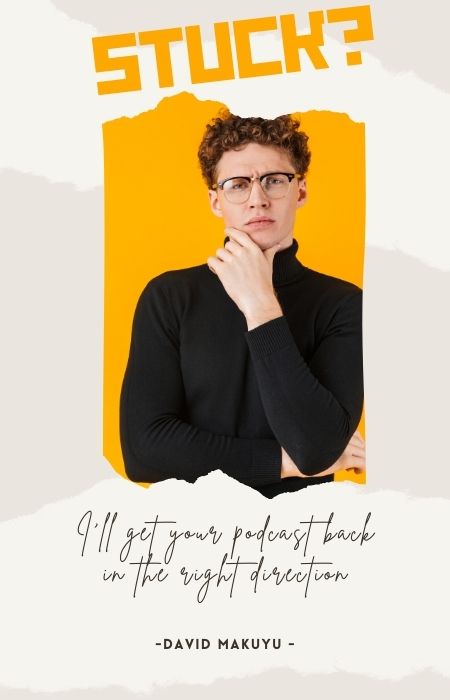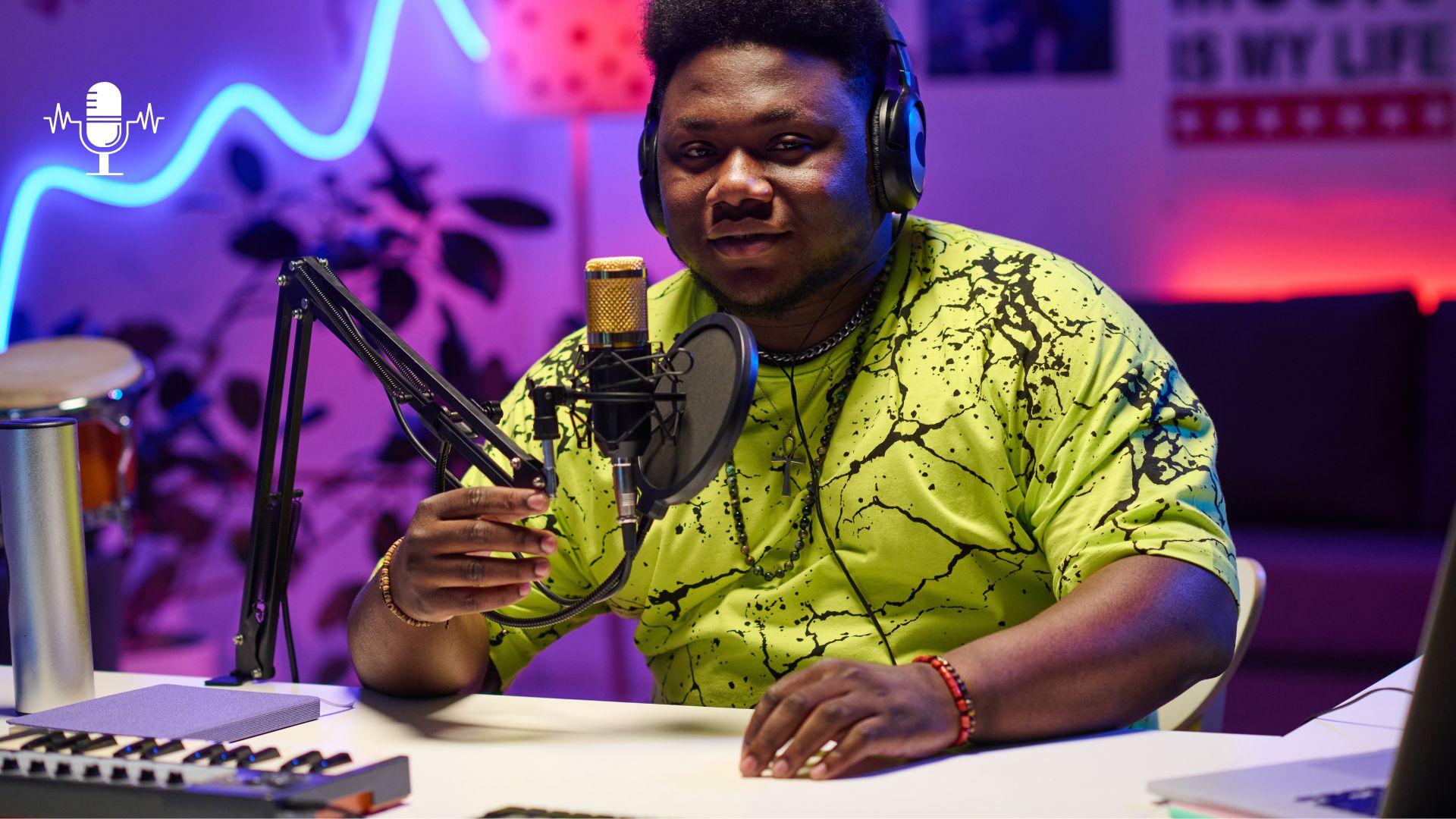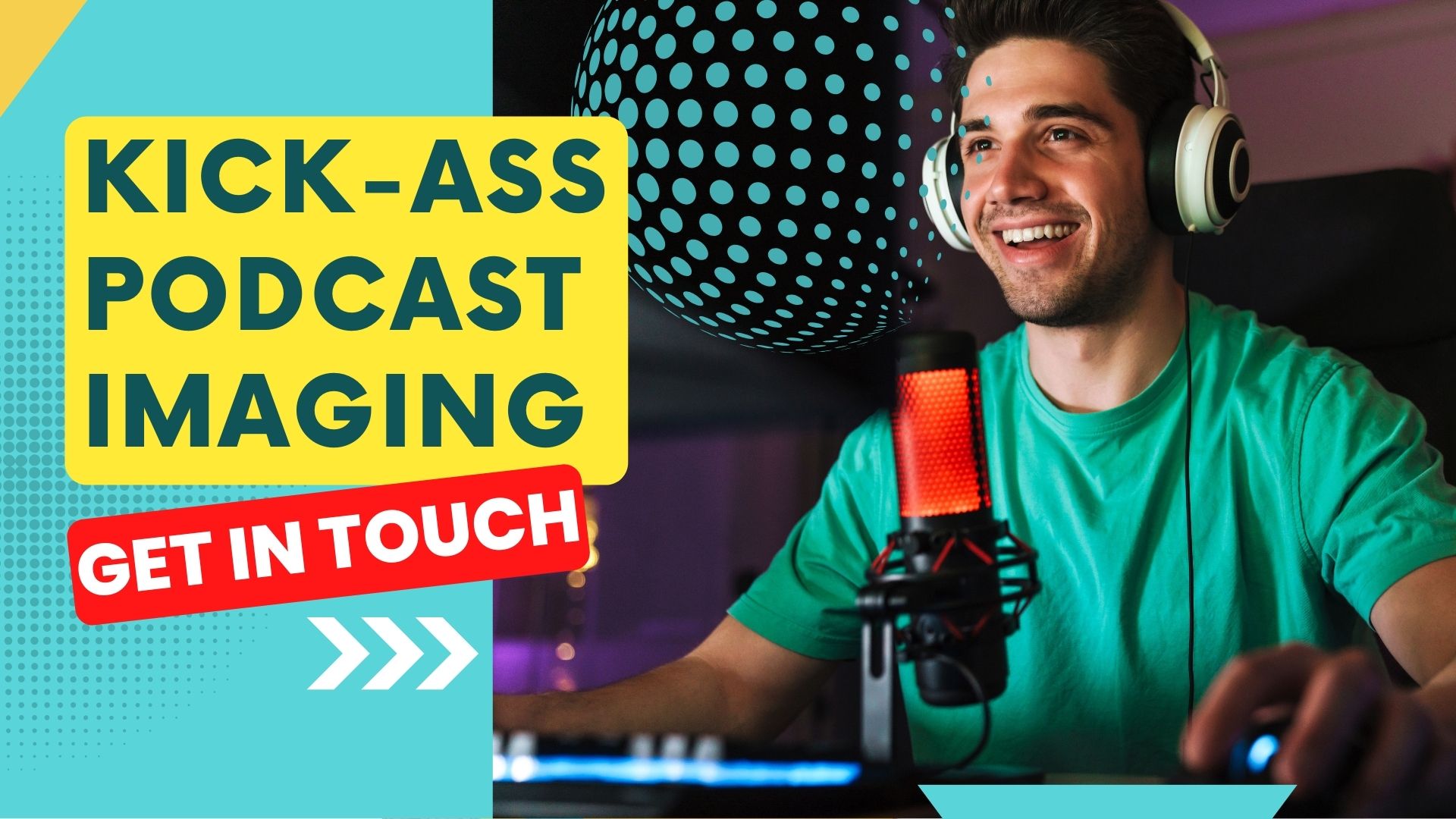Start Your Podcast In 10 Steps
So... you want to start a podcast!
And I get it…
There’s hundreds of new podcasts every day and more content creators are leaning into this low-effort, high-reward style of content.
However, starting a podcast can be daunting, which is why this article will provide you a step-by-step guide on how to start a podcast in 2025!
Start Your Podcast With These 10 Steps
Podcasting can be fairly low effort!
After all, all you need is a microphone, something to say and somewhere to store your podcast online, right?
Well, there's a little more to it than meets the eye…
You’ve got to ask yourself why you want to podcast and answer the uncomfortable question, “Who cares?”
And that the fact you’ve landed on this blog post tells me that you need some more clarity around that question.
So in this article, I'm going to share with you the exact 10 steps you need to do to get your first podcast out into the world.
Let's get into it.
1. Establish Your Intention
In my experience, people are motivated to start podcasting because of one of five key intentions:
- Top of mind awareness
- Lead generation
- Hobby
- Legacy
- Fame and fortune
Clarifying your true intention helps you know that you’ve achieved it.
This also helps you crystallize the value you are giving people.
And the success of your podcast depends ultimately on its content value. You need to make sure that your podcast offers some sort of value to your audience.
What type of podcast are you going to do?
Is it an education podcast? An entertainment podcast? An inspiration podcast? Is it instructional?
For example, my podcast, Meaningful, is an inspirational podcast where I share tips, lessons and motivational insights that I've learnt along the way that I believe will make your life more meaningful.
So my value is in help you realize more impact in your life through some of these important life lessons.
Which brings us to the next important point…
2. Content
What are you going to talk about?
There are two kinds of content:
- Evergreen
- Expiry content
Evergreen content never goes out of fashion. Money, relationships, sex, health, motivation, inspiration, spirituality, men vs women. Years from now, people will be searching and consuming this content. It never goes out of fashion.
Expiry content, on the other hand, has a specific deadline pegged to it… like gossip, news, sports. Once it passes, it's no longer relevant. Are you interested in who won the World Cup in 1982??
Now, what you talk about is really up to you but if I were you, I'd want to produce a podcast that people will listen to years from now! That kind of podcast will be working for you sort of like a passive asset that’s working as hard as you.
3. Define Your Format
The third step is to define your format. Once you're clear on your content, you want to know how to present that content.
That’s where your podcast format comes in.
You can opt for a solo, interview, group, live audience format… It really depends on you and your personality.
Now when I say your personality I mean that some people are naturally sanguine and feel better doing a podcast with people. It makes it exciting. So you’re looking at a group or interview style format… which is more engaging and lively because of the back and forth banter.
If you're a phlegmatic personality, like me, you're probably going to lean towards a solo podcast because you’re comfortable in your own space…. you want to be heard, not seen!
That’s okay. Choose you! Do it!
Next step….
4. Branding
You need to brand your podcast.
Which obviously means you need a name, logo, a tagline or punchline. Plus you need a catchy nice looking podcast cover.
There's a nifty tool you can use called Canva. I know you’ve probably heard of it. And the reason I love it is because it turns an ordinary person into an expert designer. It’s got tons of beautiful elegant podcast artwork templates. All you have to do is scroll through them, pick the one you fancy, edit the text and voila! You have a beautiful podcast cover!!
I'm sure you'll come across something that catches your eye.
Now something about images…
While most of you may want to pass by with artwork, it's much better to put your face to your podcast. People are attracted to human faces, not just fancy artwork.
You will grow your audience much faster. Again, you only need to invest in one good studio photo and that asset will work for you for years to come.
So at this point, we have identified our intention, our content, our podcast artwork and our branding assets, it's time to define your target listener.
5. Define Your Target listener
Remember what we said at the beginning of this blog post about answering the question, “Why should I care?”
The inability to answer this question from the very beginning is what makes a lot of enthusiastic podcasters give up less than a year into podcasting. And one of the ways to avoid this is to be very clear about who you are talking to. Why? Because it makes it much easier when you are coming up with topics as opposed to trying to make content that appeals to everyone.
This is one of the reasons why you love your favorite radio station. They sound as if they are talking to one person. And it's true! They are talking to one very real person with a subset of interests, beliefs and personality. Back when I was on the radio, we had a picture of this person printed and mounted in the studio. We listed everything about this person - their name, age, interests, relationship status, neighborhood, disposable income, lifestyle choices, opinions and objections.
Having all this written down helped us come up with content that was so relevant to this person that within months, a greater majority of people who were like this person were listening to us.
If you’re still stuck, post the picture of your best friend and talk to that person.
And as you record, put yourself in your listener’s shoes and ask yourself, “Why should I care?”
For example people living in Cape Town are probably not as interested in what’s happening in Accra unless it has to do with relationships or some sort of evergreen content.
Likewise, a divorced 50 year old man in Australia is probably not going to be much interested in something that relates to a 28 year old single lady living in Johannesburg.
So, be clear on the question, “Who are you talking to?” “Why should they care?”
Next up, we have imaging...
6. Imaging
Under imaging, I'm talking about well produced intros, outros, liners and liners
Most podcasters skip this step and voice their intros, outro’s and then jump right into the content.
Now you could do that, but I advise against it because you see the whole point if this is to make your podcast as memorable as possible!
Good imaging does that!
Once you invest in it, you only need to do it once.
Think Rick Dees!
There's a reason why he has the longest Number 1 Top 40 Countdown Chart show.
Yes, his content is well researched… yes it’s a countdown show...
But...
The imaging is memorable.
Most podcasters don't invest in imaging so they all sound the same so this is your chance to sound different.
Be unique.
If you want to get started with this, I’ll recommend some resources in the description below.
But for starters, check out one of my favorite sources of top quality royalty-free music, Audiojungle.
Epidemic Sound is another good source.
But whatever you do, don’t use any popular music from your favorite artist. It’s probably got a number of royalty rights pegged to it. You don’t want to receive a call from Justin Timberlake saying “Dude, you used my song! You owe me a million dollars because I didn't give you rights to it!”
I mean it would be nice for him to call you but to probably ask if he can be a guest on your show!!!
The thing I like about Audio Jungle is that they have fantastic music in practically every music genre you can think of - from inspirational to pop, afrobeat, reggae, jazz. And… all you do is pay a one time fee and you can use that track for as long as you wish.
For spoken jingles and liners, Fiverr is my top pick.
If you need some kick-ass imaging, let's chat!
7. Audio Gear
Okay, now audio gear!
You will need:
- A dynamic microphone
- Headphones
- An audio interface
- Laptop
- A digital audio workstation (DAW)
- And accessories like a pop shield and XLR cables
You don't need to break the bank on this.
I see a lot of people investing in the Shure SM7B but the truth is there are cheaper mics that will give you probably better results than the Shure SM7B. Not that I have anything against it, but if you don't have the budget, don't sweat it.
Here are a couple of my favorites...
- Behringer XM8500 S
- Rode Podmic
- Shure SM58
- Shure SM57
- Shure Beta 87A
- Electrovoice RE20
You're already familiar with mics, headphones. But a DAW needs a little more explanation.
A DAW stands for digital audio workstation. This is the app on your laptop that receives your audio signal, allowing you to edit and produce your podcast episode. Thankfully, there are a couple of good options like Garageband, Adobe Audition or Audacity if you use Windows. Any of these programs will help you record, edit, and produce a really great sounding podcast.
I've written a post about the best digital audio workstations in the market. The round-up includes easy-to-learn and more advanced DAW's.
( Btw, I have a new course titled "Beginner's Guide to Adobe Audition", now online on Udemy. This is for content creators and podcast enthusiasts who want to take control of their own audio post-production projects. Click here)
8. Recording
Let's talk about recording…
It’s important to note that if you record something that’s distorted, no amount of post-production magic will rectify it.
So the easiest way to ensure that you always have a crisp clear recording is to use a pop filter and keep the microphone at least a fist away from your mouth. Don’t come too close or you will sound muffled.
You're looking for a bright, crisp, clear recording.
I don't get tired of saying this; "If you record badly, it doesn't matter what you do in production, it’s going to sound BAD.”
Again, I go into more details on exactly how to guarantee a crisp clear recording in my Adobe Audition tutorial so sign up for it if you need more info on how to produce a great sounding podcast.
9. Distribution
Once you're done with recording and editing, you are now ready to share your podcast with the world.
You will need a podcast hosting provider.
A podcast hosting provider is a place where your podcast is stored online. If someone wants to listen to it, the hosting provider provides a feed called an RSS Feed that links your podcast to your listener.
Because this takes a lot of disc space, most hosting providers charge you a monthly fee, but there are some free ones.
Interestingly enough, WordPress offers you a free hosting platform. I don’t know why people are not talking about this!
I use Spotify for Podcasters.
Spotify for Podcasters used to be called Anchor until Spotify bought it years ago.
The good thing about Spotify For Podcasters is that it gives you options to distribute your podcast to the entire Spotify audience.
The more people listen to it, the more Spotify increases its reach and you gain new listeners.
There’re lots more excellent providers like YouTube, Acast, Zencast, Afripods, SimpleCast, Buzzsprout and RSS.com.
(Btw... let me know in the comments below if you want me to do an in-depth video on the best podcast hosting providers for you.)
Speaking of which..
10. Marketing & Promotion
I wish I could tell you that once you upload your podcast onto Apple or Google Podcasts the entire world will know about your podcast.
WRONG.
This is where most podcasters get discouraged.
Apple and Google podcasts are nothing more than listing platforms.
All they do is list you in a category and provide a link to your podcast.
You still need to do the heavy lifting and market your podcast to the world.
There are thousands of podcasts online so no one knows and no one cares.
The easiest way to do marketing is to start with your family and close friends. Let them know. Hype it up to your relatives, aunties, uncles... you want people clicking on that link.
Then head to social media… but not just any social media platform. Use Twitter, Facebook and LinkedIN.
I say Facebook because the best thing you can do is push a FB ad to a very targeted audience demographic. With Facebook you can whittle down to an audience that’s directly interested in what you’re talking about. If your podcast is about cats, Facebook literally allows you to narrow down to a segmented audience that lives, breathes and talks about cats. Market your podcast to them. Forget everyone else.
I see lots of people promoting their podcasts on Instagram.
I don't agree.
Instagram is a visual platform so it's unlikely that people will want to listen to it unless you post it as a video.
(BTW, in this article, I’m focusing on a traditional audio-only podcast and not a video podcast)
If you want to grow your community organically, use LinkedIn. I don’t know what algorithm they are using but LinkedIn is crazy!! They want you to get famous pretty quick!
You can also use Youtube, although I suggest that you produce trailers that you upload on Youtube that push people to your website or Apple/Google Podcast link.
And then use X.com to post short text snippets from your podcast along with a link to your latest episode.
One thing to be prepared for… it will take time to grow an audience. In my experience, you’re looking at at least one year. So, the most important thing you can do is point everyone who listens to your podcast to an email list to become subscribers. That way, when you publish your next episode, you simply have to shoot a quick email to your database and you have a ready audience!
I'll say it again, the most important thing you can do is build an email list from the very beginning.
(I’m going to share more about the best email subscription providers you should use as a content creator in a future video.)
Once they are subscribers, you’re able to connect with them one on one, get invaluable insights about who they are, what they like about your podcast and what kind of content they want more of.
And then incentivize them with giveaways, prizes, shout-outs… everyone loves a shout-out!
I remember when I was on the radio, the most popular show was the Saturday Request show. Why? because people wanted to hear the presenter say their name! Yeah, cue the song "Say my name...!"
We are vain… we love the sound of our names!
So, shout-out your listeners.
Get that email list working!
Before you sweat too much recording 15 episodes, even 1 episode…email subscribers.. that’s your currency!
Put your subscription link in your Facebook profile, your twitter profile, your LinkedIn bio, everywhere!!
Push people onto that list and suddenly you have a loyal audience that you can market every episode you publish for as long as you want.
Apply These 10 Steps And You'll Be Off To A Good Start
Great!!
So by now I hope you have a clear understanding of what you need to do to start your podcast!
Can’t wait to see what you create!
And yes, if you already have a podcast, I’d love to listen to it…. and give you a shout-out!!
Don't forget to subscribe! Talk soon!





Leave a Comment: